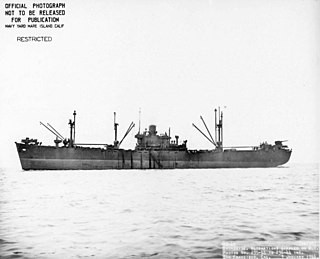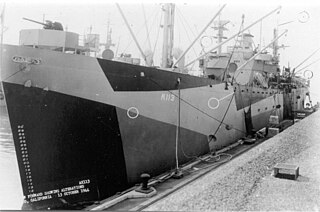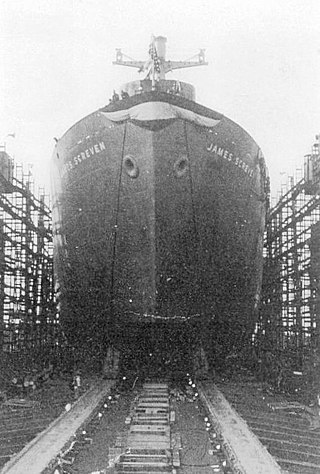Service history
Increase A. Lapham was a Liberty ship laid down under a Maritime Commission (MARCOM) contract, MC hull 1584, on 10 June 1943, at Richmond, California, by the Permanente Metals Corporation, Yard No. 2; launched on 29 June 1943; sponsored by Mrs. Chester P. Kenman; acquired by the Navy on 5 October 1943; converted for naval service by the Hurley Marine Works, Oakland, California; renamed Alkes (AK-110) on 6 October 1943; and placed in commission at Oakland on 29 October 1943.
After shakedown training, the new cargo ship got underway for Pearl Harbor, Hawaii, her base of operations while she carried supplies to the forward areas in the Pacific Ocean. In early December, the ship sailed to the Gilbert Islands with Task Unit (TU) 16.15.1. She reached Makin Island on 16 December, and commenced unloading. The ship moved to Baker Island on 31 December, to take on cargo prior to returning to Pearl Harbor, where she arrived on 13 January 1944. Shortly after returning to Hawaii, the vessel began taking on supplies and equipment for another shuttle run. Alkes sailed on 25 January for the Marshall Islands. Upon reaching Majuro Atoll, on 3 February, the ship began unloading her cargo to support ongoing landing operations. One week later, she reversed her course and arrived back at Pearl Harbor on 21 February.
Alkes got underway again on 12 March, bound for the Marshall and Gilbert Islands with Task Group 16.12. Among her ports of call were Eniwetok, Kwajalein, and Majuro, Marshall Islands; and Tarawa and Makin, Gilbert Islands. Alkes returned to Pearl Harbor on 8 May, to replenish her cargo. She shaped a course back to the Marshalls on 22 May and made stops at Kwajalein and Eniwetok. The vessel arrived at Guam on 8 August, where she remained for one month discharging cargo and delivering fresh water to various ships of the fleet.Alkes arrived back at Pearl Harbor on 11 September. After 10 days in port, she continued sailing east toward the United States. The vessel reached San Pedro, California, on 3 October and, shortly thereafter, began alterations and repairs. She moved to San Francisco, California, on 27 October, to take on cargo and, on 6 November, sailed for Pearl Harbor.
The ship reached Hawaiian waters on 16 November, and sailed the next day for Eniwetok, Guam, and Ulithi. Alkes reached Ulithi on 13 December, and assumed duty there as a fleet issue ship. She operated at Ulithi until 6 February 1945, when she got underway for a return voyage to California. Alkes arrived at San Pedro on 4 March and underwent repairs while taking on supplies and equipment. She sailed on the 23d to resume her cargo operations in the Western Pacific. On 12 April, the ship returned to Ulithi, where she remained until late May, preparing for the impending assault on the Ryūkyūs.Alkes got underway with TU 13.11.2 on 23 May, bound for Okinawa. She remained off that island and Kerama Retto from 28 May through 13 August issuing her cargo to units of the invasion force. She experienced numerous air attacks but continued to carry out her duties without sustaining any serious damage.
She left Okinawa in mid-August and sailed via Ulithi to the west coast of the United States. The ship again reached San Pedro on 14 September and remained there until early January 1946, serving as a fleet issue ship. On 3 January, she set a course for the US East Coast. Having transited the Panama Canal, Alkes arrived at Norfolk, Virginia, on 31 January. Preparations for her inactivation were then begun. The vessel sailed to Baltimore, Maryland, on 8 February and was placed out of commission there on 20 February 1946. She was returned to the Maritime Administration on 27 February, and her name was struck from the Navy List on 12 March 1946. The ship was subsequently laid up in the National Defense Reserve Fleet, James River Group, Lee Hall, Virginia, as SS Increase A. Lapham. She was sold on 26 October 1971, to Hierros Ardes S. A., Bilbao, Spain, for scrapping.

USS Altamaha (AVG-18/ACV-18/CVE-18) was an escort aircraft carrier in the United States Navy during World War II. She was named for the Altamaha River in Georgia.

USS Giansar (AK-111) was a Crater-class cargo ship originally laid down as the liberty ship SS Thomas Ewing. The ship was taken over by the United States Navy and renamed in 1943. After being decommissioned in 1945, Giansar was returned to the Maritime Commission. She was scrapped in 1963. The ship's original name honored Thomas Ewing, an American politician from Virginia. The name Giansar is a former name of the star λ Draconis in the constellation Draco now spelled Giausar.

USS Cheleb (AK-138) was a Crater-class cargo ship in the service of the US Navy in World War II. It was the only ship of the Navy to have borne this name. It is named after Cheleb, a star in the northern hemisphere constellation of Ophiuchus.

The USS Alnitah (AK-127) was a Crater-class cargo ship in the service of the US Navy in World War II. Named a spelling variation of the star Alnitak in the constellation Orion, it was the only ship of the Navy to bear this name.

USS LST-31 was a United States Navy LST-1-class tank landing ship used exclusively in the Asiatic-Pacific Theater during World War II. Like many of her class, she was not originally named and is properly referred to by her hull designation. Later she was named for Addison County, Vermont. She was the only US Naval vessel to bear the name.

USS Deede (DE-263) was an Evarts-class destroyer escort in the United States Navy.

USS Salem (CM-11) was a commercial cargo ship, that served as a minelayer and then net laying ship of the United States Navy during World War II.
The second USS Dempsey (DE-26) was an Evarts-class destroyer escort constructed for the United States Navy during World War II. She was promptly sent off into the Pacific Ocean to protect convoys and other ships from Japanese submarines and fighter aircraft. By the end of the ship's World War II service career, when she returned to the United States, she had accumulated three battle stars.

USS Bangust was a Cannon-class destroyer escort in service with the United States Navy from 1943 to 1946. In 1952, she was sold to Peru, where she served as BAP Castilla (D-61). She was decommissioned and scrapped in 1979.

USS Auriga (AK-98) was an Auriga-class cargo ship, the only ship in her class, commissioned by the U.S. Navy for service in World War II, named after the constellation Auriga. She was responsible for delivering troops, goods and equipment to locations in the war zone.

USS Allioth (AK-109/IX-204/AVS-4) was a Crater-class cargo ship commissioned by the US Navy for service in World War II, named after Alioth, a star in constellation Ursa Major. She was responsible for delivering troops, goods and equipment to locations in the war zone.

USS Rutilicus (AK-113) was a Crater-class cargo ship commissioned by the US Navy for service in World War II. She was responsible for delivering troops, goods and equipment to locations in the Asiatic-Pacific Theater.
USS Alderamin (AK-116) was a Crater-class cargo ship commissioned by the U.S. Navy for service in World War II, named after Alderamin, the alpha star in constellation Cepheus. She was responsible for delivering troops, goods and equipment to locations in the war zone.

USS Shaula (AK-118) was a Crater-class cargo ship, converted from a Liberty Ship, commissioned by the US Navy for service in World War II. She was first named after James Screven, an American general during the American Revolutionary War. She was renamed and commissioned after Shaula, the second-brightest star system in the constellation of Scorpius. She was responsible for delivering troops, goods and equipment to locations in the war zone.

USS Azimech (AK-124) was a Crater-class cargo ship commissioned by the US Navy for service in World War II, named after the Azimech, the other name of Spica, the brightest star in constellation Virgo. She was responsible for delivering troops, goods and equipment to locations in the war zone.

USS Ara (AK-136) was a Crater-class cargo ship commissioned by the US Navy for service in World War II. Ara is named after the constellation Ara. She was responsible for delivering troops, goods and equipment to locations in the Asiatic-Pacific Theater.

USS Ascella (AK-137) was a Crater-class cargo ship commissioned by the US Navy for service in World War II. Ascella was named after Ascella, a star in the constellation Sagittarius. She was responsible for delivering troops, goods and equipment to locations in the Asiatic-Pacific Theater.
USS Pavo (AK-139) was a Crater-class cargo ship commissioned by the U.S. Navy for service in World War II, named after the constellation Pavo. She was responsible for delivering troops, goods and equipment to locations in the war zone.

USS Adria (AF-30) was an Adria-class stores ship in service with the United States Navy from 1944 to 1954. She was scrapped in 1977.

USS Livingston (AP-163/AK-222) was a Crater-class cargo ship built for the US Navy during World War II. She was responsible for delivering troops, goods and equipment to locations in the Asiatic-Pacific Theater.

















